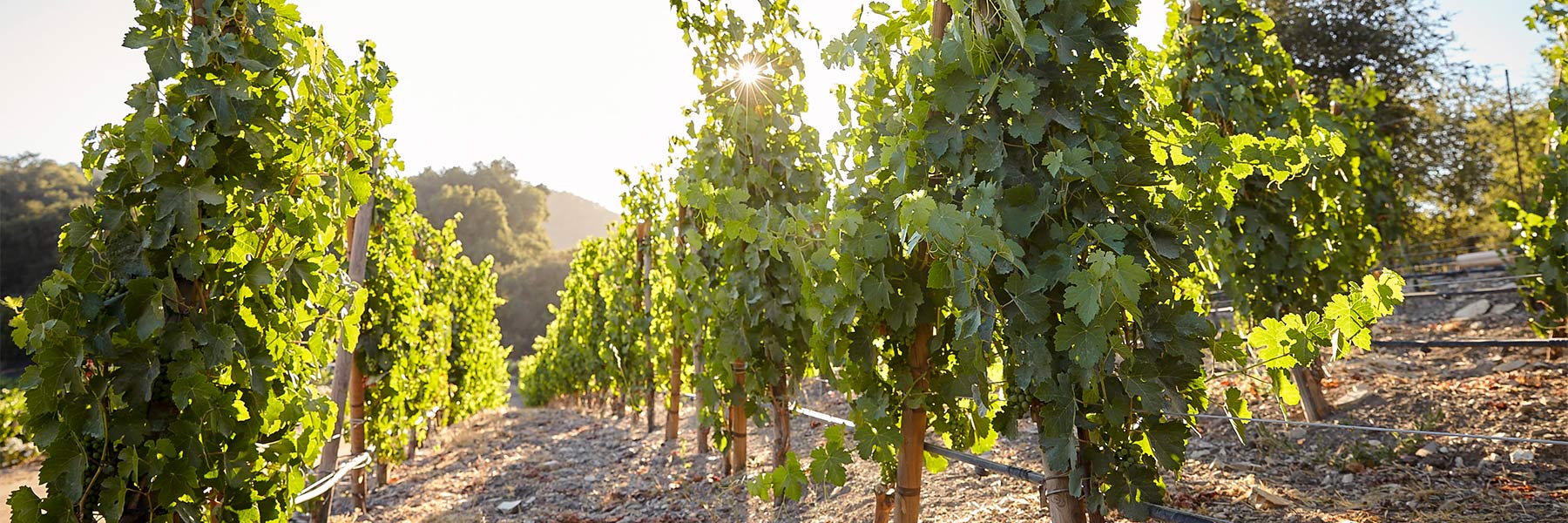The Vineyard
“Our little “Clos” has finally become an estate!” says Solène. Guillaume and Solène actively searched for a piece of land to call home for several years. It was always part of the dream and the goal – owning their own vineyard to give as much attention to the quality of the grapes as possible. “It was a big step, and as impatient as we can be, we took our time to find the right property, and it was not easy…. maybe even harder than finding the right man!” Solène winks.
After years of searching, they found Pipestone Vineyards, a westside Paso Robles winery with 8 acres planted on energetic American rootstock in the heart of Willow Creek District. The property is a total of 28 acres, with plans to have 18 acres under vine by 2021.
The Estate Vines
When Guillaume and Solène acquired the estate in January of 2017, the existing vineyard was planted in 1998 onto vigorous rootstock. The rows were planted a little wider than Guillaume would have planted, but he felt that it was a great place to start, especially having 20-year-old vines in place, which is considered “old vines” for this area. After testing to make sure the vines were clean of any and all viruses, Guillaume decided to re-graft the whole 8 acres and turn the plot into a nursery for future planting. Today, there are 10 different varieties and 16 different clones. Half of the vineyard was grafted to Rhone varieties (Grenache, Syrah, Mourvèdre). The Rhone varieties were grafted based on the soil, mostly shale with steeper slopes. The other half of the vineyard was grafted with Bordeaux varieties, where the soil has a better capability to hold water.
The new plantings will take place in 2018 and will end in 2021. The estate has excellent sun exposure (mostly southwest) and texture making for very proper Rhone-style soil for his Rhone program. Close to 9 acres will be planted in different phases – Grenache, Mourvèdre, and Syrah will be the main varieties, but he will also include Cinsault, Terret, Clairette, Bourboulenc, Macabeu… a few Rhone varieties that are not as common in the Paso Robles region. The remaining 2 acres are going to be planted with very selective clones of Cabernet Sauvignon, Cabernet Franc, and Petit Verdot. These 2 acres have deeper soils and will host these special Bordeaux varieties well. The goal for the next 10 years is to be at full production of about 3,500 to 4,000 cases using estate fruit, however, Guillaume will always keep the vineyard blocks he is leasing today.
The Westside Vineyards
For the past 10 years, Clos Solène has been purchasing fruit, and will most likely always purchase fruit. As a Rhone producer, 90% of the wine he makes is Rhone inspired, but Guillaume likes to play with other varieties to learn and accomplish something he couldn’t do in France. Guillaume’s philosophy is to create blends that represent different soil types and climates and to achieve this you must use many different terroirs. However, all of the fruit that is purchased is coming from the west side of Paso Robles, mainly from the Willow Creek District and the Adelaida District. The soil types represented are clay, loam, calcareous, limestone, and shell. The west side of Paso Robles is highly influenced by the Pacific Ocean with cool nights, foggy mornings, and warm days. This region is known for having the largest day to night temperate swing, as much as 50 degrees, of any growing region in California.
Bien Nacido Vineyard
As Guillaume’s passion for California soil grew, Clos Solène started to lease some of the best blocks of Pinot Noir, Syrah, and Chardonnay from Bien Nacido Vineyard in Santa Maria Valley. Bien Nacido is recognized for its meticulously maintained vines and for its cool climate influences. Clos Solène makes limited production cuvées for their wine club members from Pommard and Martini clones.
Paso Robles AVA
The Paso Robles AVA lies in the Monterey Formation which was formed 2 million years ago. The old marine deposits are about 1,000 ft underground and are composed of diatoms, which are silica (dissolved particles) of marine animals. After thousands of years of water passing through the rocks it became concentrated with calcium carbonate, aka, “Float Rock.” Float rock is the lightweight rock that you find on the property. The float rock is highly soluble and contains high traces of salt. If you were to put one into a bowl of water they will float, but they will also absorb water and you will notice them bubbling during this process.

